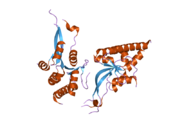SMG6
Ensembl | |||||||||
|---|---|---|---|---|---|---|---|---|---|
| UniProt | |||||||||
| RefSeq (mRNA) | |||||||||
| RefSeq (protein) | |||||||||
| Location (UCSC) | Chr 17: 2.06 – 2.3 Mb | Chr 11: 74.82 – 75.06 Mb | |||||||
| PubMed search | [3] | [4] | |||||||
| View/Edit Human | View/Edit Mouse |
Telomerase-binding protein EST1A is an
Structure
Gene
The SMG6 gene resides on chromosome 17 at the band 17p13.3 and contains 30
Protein
SMG6 is one of three human
Function
SMG6 is broadly expressed in all human tissues. It has dual functions in
Clinical significance
In humans, selected genomic regions based on 150 SNPs were identified in a genome-wide association study (GWAS) on coronary artery disease. Accordingly, the association between recent smoking and the CpG sites within and near these coronary artery disease-related genes were investigated in 724 Caucasian subjects from the Rotterdam Study. The identified methylation sites were found in SMG6 together with other genes, and several of these sites exhibited lower methylation in subjects currently smoking compared to never smoking.[22]
Clinical marker
A multi-locus genetic risk score study based on a combination of 27 loci, including the SMG6 gene, identified individuals at increased risk for both incident and recurrent coronary artery disease events, as well as an enhanced clinical benefit from statin therapy. The study was based on a community cohort study (the Malmo Diet and Cancer study) and four additional randomized controlled trials of primary prevention cohorts (JUPITER and ASCOT) and secondary prevention cohorts (CARE and PROVE IT-TIMI 22).[12]
References
- ^ a b c GRCh38: Ensembl release 89: ENSG00000070366 – Ensembl, May 2017
- ^ a b c GRCm38: Ensembl release 89: ENSMUSG00000038290 – Ensembl, May 2017
- ^ "Human PubMed Reference:". National Center for Biotechnology Information, U.S. National Library of Medicine.
- ^ "Mouse PubMed Reference:". National Center for Biotechnology Information, U.S. National Library of Medicine.
- ^ S2CID 14423276.
- ^ S2CID 6685276.
- ^ "Entrez Gene: SMG6 Smg-6 homolog, nonsense mediated mRNA decay factor (C. elegans)".
- ^ "BioGPS - your Gene Portal System". biogps.org. Retrieved 2016-10-12.
- PMID 16820686.
- S2CID 6685276.
- PMID 18974281.
- ^ PMID 25748612.
- ^ "SMG6 SMG6, nonsense mediated mRNA decay factor [Homo sapiens (human)] - Gene - NCBI". www.ncbi.nlm.nih.gov. Retrieved 2016-10-12.
- ^ "SMG6 - Telomerase-binding protein EST1A - Homo sapiens (Human) - SMG6 gene & protein". www.uniprot.org. Retrieved 2016-10-12.
- PMID 17053788.
- S2CID 43477604.
- PMID 18974281.
- PMID 25013172.
- PMID 10037601.
- PMID 18974281.
- PMID 25053839.
- PMID 26015811.
Further reading
- Nakajima D, Okazaki N, Yamakawa H, Kikuno R, Ohara O, Nagase T (June 2002). "Construction of expression-ready cDNA clones for KIAA genes: manual curation of 330 KIAA cDNA clones". DNA Research. 9 (3): 99–106. PMID 12168954.
- Nagase T, Ishikawa K, Suyama M, Kikuno R, Miyajima N, Tanaka A, Kotani H, Nomura N, Ohara O (October 1998). "Prediction of the coding sequences of unidentified human genes. XI. The complete sequences of 100 new cDNA clones from brain which code for large proteins in vitro". DNA Research. 5 (5): 277–86. PMID 9872452.
- Hoff C, Seranski P, Mollenhauer J, Korn B, Detzel T, Reinhardt R, Ramser J, Poustka A (November 2000). "Physical and transcriptional mapping of the 17p13.3 region that is frequently deleted in human cancer". Genomics. 70 (1): 26–33. PMID 11087658.
- Chiu SY, Serin G, Ohara O, Maquat LE (January 2003). "Characterization of human Smg5/7a: a protein with similarities to Caenorhabditis elegans SMG5 and SMG7 that functions in the dephosphorylation of Upf1". RNA. 9 (1): 77–87. PMID 12554878.
- Ohnishi T, Yamashita A, Kashima I, Schell T, Anders KR, Grimson A, Hachiya T, Hentze MW, Anderson P, Ohno S (November 2003). "Phosphorylation of hUPF1 induces formation of mRNA surveillance complexes containing hSMG-5 and hSMG-7". Molecular Cell. 12 (5): 1187–200. PMID 14636577.
- Fukuhara N, Ebert J, Unterholzner L, Lindner D, Izaurralde E, Conti E (February 2005). "SMG7 is a 14-3-3-like adaptor in the nonsense-mediated mRNA decay pathway". Molecular Cell. 17 (4): 537–47. PMID 15721257.
- Azzalin CM, Lingner J (February 2006). "The human RNA surveillance factor UPF1 is required for S phase progression and genome stability". Current Biology. 16 (4): 433–9. S2CID 17197870.
- Takeshita D, Zenno S, Lee WC, Saigo K, Tanokura M (July 2006). "Crystallization and preliminary X-ray analysis of the PIN domain of human EST1A". Acta Crystallographica Section F. 62 (Pt 7): 656–8. PMID 16820686.
- Glavan F, Behm-Ansmant I, Izaurralde E, Conti E (November 2006). "Structures of the PIN domains of SMG6 and SMG5 reveal a nuclease within the mRNA surveillance complex". The EMBO Journal. 25 (21): 5117–25. PMID 17053788.
- Takeshita D, Zenno S, Lee WC, Saigo K, Tanokura M (September 2007). "Crystal structure of the PIN domain of human telomerase-associated protein EST1A". Proteins. 68 (4): 980–9. S2CID 43477604.



